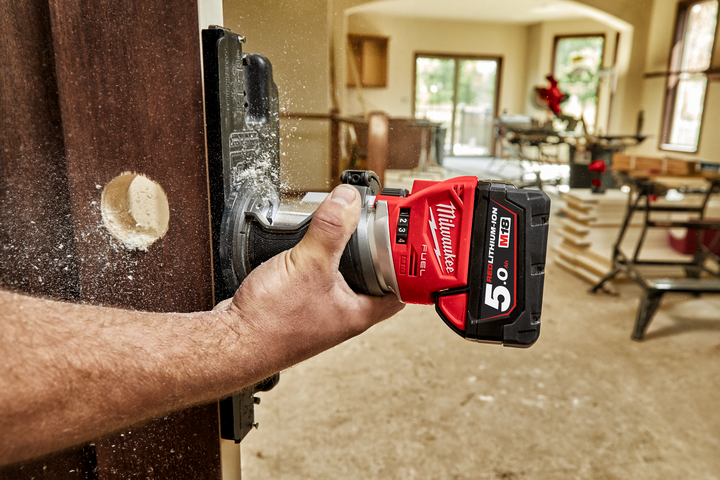Tradies, chippies, and hobbyists alike all love the power and versatility they have with their regular-sized routers. From their unlimited freehand cutting abilities, to the sheer range of precision jigs and templates they can be used with to produce thousands of the most optimally cut shapes imaginable, routers have become irreplaceable when it comes to woodworking.
That’s why it’s no wonder that woodworkers look so favourably on smaller, lighter, but equally capable laminate routers. Laminate routers can do all the cutting, shaping, and trimming that bulky regular-sized routers can, but they offer a level of ease, accuracy, and convenience that’s all their own. A beefy 3½HP regular-sized router spinning at 22,000RPM can cut window and door openings all day, but a compact 1HP laminate router running at 30,000RPM can profile the mouldings for all of those window and door openings quicker, and more intricately than any other tool that doesn’t weigh a ton.
Let’s take a look at what gives these fast-turning, handheld cutters the edge over regular-sized routers. And in the hands of a skilled woodworker, we’ll see how they can even take the place of some other, more conventional tools as well.
Big Benefits of Laminate Routers

It doesn’t matter if you’re a professional carpenter or a diehard DIYer, it’s never easy to decide which tools you can get the most value out of. And it’s an especially hard choice when it comes to power tools, where so many of them come in larger and smaller versions. Lightweight, multi-purpose laminate trimmers, however, are one of the most essential tools a woodworker can have in their workshop, and you’d be hard-pressed to find a tool that woodworkers hold in higher esteem, regardless of its size.
Size, in fact, is one of the laminate router’s greatest attributes. With their ¼” collets, laminate routers can’t do the grunt-cutting that regular-sized routers with ½” shank bits ordinarily do. It’s this down-sizing, however, that gives them benefits like:
- Less weight. With smaller motors and typically less aggressive bits to rotate, laminate routers normally weigh less than a third of what regular-sized routers do.
- Improved maneuverability. A laminate router’s smaller motor reduces its size to a dimension that makes it easy to control with only one hand, leaving the operator with a free hand to help hold the stock steady.
- Greater accuracy. The smaller base plate on a laminate trimmer allows it to make more accurate cuts, to cut freehand, or to cut at precise tilts when supplied with a tilted base.
- Increased portability. Working on elevated or overhead projects would be more than a challenge with a heavy, regular-sized router, but it’s effortless with an ergonomic handheld laminate router.
- The perfect price. Size and price are relative when it comes to power tools, and a compact trimmer router for sale only costs a fraction of what regular-sized routers do.
From a performance standpoint, the advantages that laminate routers have over their full-sized counterparts are clear. And when you look carefully at what makes these powerful little cutters tick, it becomes even easier to understand why they’re so desirable with all levels of woodworkers.
Laminate Router Specs

Even though their compact size is a major part of what makes a laminate router appealing, they’re not at any disadvantage for a lack of power. To cut, edge, and trim as smoothly as they do, they need strong, high-speed motors and credible specs to perform, and laminate routers are known for:
- Powerful 500W – 530W high performance motors;
- Smooth running, no load speeds up to 35,000RPM;
- External brushes for easy servicing;
- Plunge capacities from 0 – 42mm; and,
- Low sound and vibration levels.
A laminate trimmer machine contains all the power and performance that woodworkers need, and they pack it into a slim-bodied housing that’s just as durable as any regular-sized router is. The real proof is in how well they cut though, and you only have to look at a few of the most routine router jobs to see the true range of their capabilities.
Making Furniture With Laminate Routers
Although trimmer-type routers were first conceived for trimming and cleaning veneer and laminates for floors and countertops, they’ve expanded to become standard tools for everything from cabinet and furniture making, to creating one-of-a-kind headboards and grill panels. Rabbets, dadoes, mortises, and all types of joinery cuts that hold these projects together are effortless with handheld routers. With the proper selection of jigs and templates, trimmer routers are unrivalled when it comes to intricate dovetails and inlays, and their ability to create and duplicate unique patterns is a core capability that used to be reserved almost exclusively for hand chisels.
Laminate Routers for Perfect Profiles

Regular-sized routers are great for big-cutting, high-volume jobs, but trimmer routers are the undisputed champions for the shaping and edge profiling that ultimately defines a project. With hundreds of different types of ¼” bits to choose from, it’s possible to cut any size or depth of profile that you can think of. Mouldings, shelves, and cornices are only a few of the straight-edged surfaces and decorative lips that these power tools are excellent at working on; and the lightness and comfort of using a trimmer router give woodworkers the ability to finish off freehanded chamfers and round overs with a delicacy that require only light sanding afterwards.
Perfect Holes With Laminate Routers
A laminate floor trimmer may not be the first tool that springs to anyone’s mind when it comes to boring holes, but they’re more effective than common drills in many cases for making holes. Their consistent plunging capacity makes them the perfect tool for boring shelf and dowel pin holes, counterbore and countersink holes, and clearance holes. And jigs and guides let woodworkers expand their trimmer’s uniformed drilling capabilities even further to produce all sizes of round and round-cornered square holes to practically any depth that’s desired.
The Final Word
At the end of the day, routers are probably the most versatile woodworking power tools that any tradie or carpenter can have in their arsenal. They do everything well, but there are a lot of things that they can do significantly better once they’re scaled down in size.
The type and degree of work that can be done with lightweight laminate trimmers is nothing short of impressive. They provide a level of smooth, detailed productivity that simply isn’t possible with regular-sized routers, or even with most hand tools. So, if you enjoy working with wood and you’re looking at handy, affordable power tools that have the capacity to do it all, you want to look at laminate routers.



















